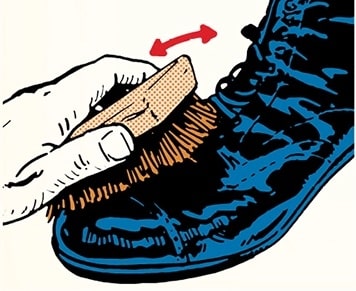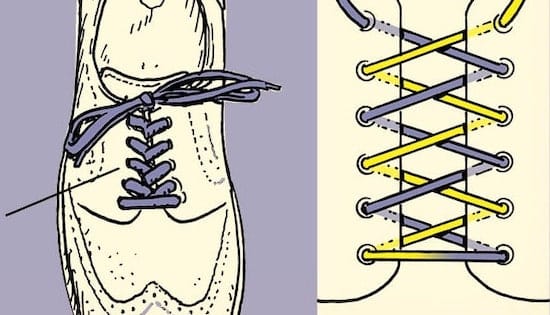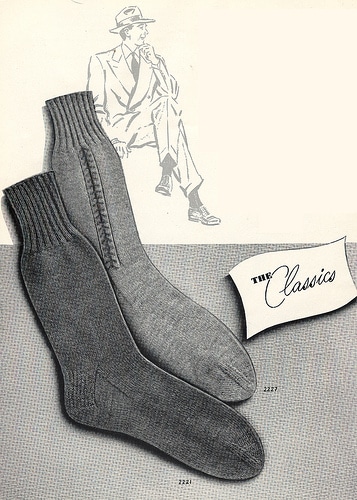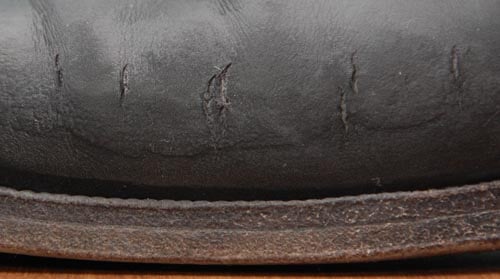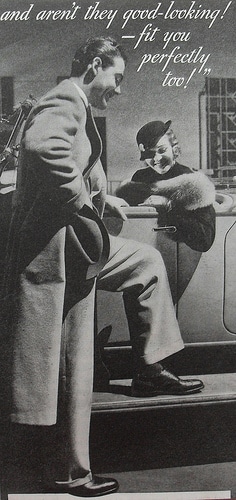
Over 70 years ago, archeologist Luther Cressman discovered perhaps the world’s oldest footwear in Central Oregon. The sandals were dated to be 10,000 years old, and from the pictures I’ve seen, were made with intricate weaves that indicated they were not only functional, but also stylish in design. From our tribal days to modern times, men have searched for and valued footwear that both looked good and got the job done.

Luther Cressman and the sandals that he discovered in central Oregon.
The goal of this article is to give you an overview of a man’s options when it comes to footwear and explain how to wear them when. I’m not going to try to sell the idea that you need a pair of shoes for every occasion, but I would like to expose you to the concept that quality footwear that fits well is a worthy investment, and that the right shoes for the right situation can substantially elevate your personal style and comfort.
Why care about your shoes?
A man should care about his footwear if for no other reason than the fact that it constitutes the very foundation he stands upon. In an average day, you’ll ask your shoes to absorb the force of your weight 3000+ times; a poor choice here can lead to not only discomfort but injury one step at a time, especially if you select shoes that inhibit your body’s natural gait and cushioning system.

Andy Dufresne was right about everything, except this: People do notice a man’s shoes.
Then there is the appearance aspect. Separate from the rest of your clothing, shoes are a visual endpoint and receive a disproportional amount of attention; despite covering only 5% of your body they can make-up more than 30% of the visual judgement we make when sizing up a stranger.
Ideally you want to choose footwear that is both functional and stylish–by following these footwear selection principles this goal can be easily achieved.
Four Footwear Rules
1st – Wear the right shoe for the occasion – this is the most common mistake I see men make when it comes to footwear. Running shoes have a purpose; they protect your feet while running. Steel toe work boots have a purpose; they protect your feet while working. And wearing these shoes outside their prescribed function is fine as long as they are still appropriate; however, many of us take this to an extreme and have abandoned the middle ground between formal and ultra-casual.
2nd – Invest in quality – Not every man can afford to spend hundreds of dollars on his shoes; however, many of those who can instead choose to waste money elsewhere and buy new inferior shoes every few years. This is never a winning strategy, as low quality footwear is held together with glue and made with cheap raw materials such as cardboard and paper that does not age well. You can save money in the long term by buying more expensive shoes that last for decades.
I want to expand on this point just a bit more; to buy quality, many men will have to save and budget for the purchase. This isn’t a bad thing–in fact, it can instill a respect for the quality of the product and encourage you to take better care of them when purchased.
And don’t forget the thrifting option. Assuming you can find a pair of quality shoes that fit you from Allen Edmonds, Alden, or another manufacturer, you can send them back and take advantage of their re-crafting and re-soling service. A new pair of shoes for a fraction of the cost, rebuilt to serve you for 20 years.
3rd – Never sacrifice proper fit and comfort – buy the right shoe size, even if this means paying a bit more and purchasing your shoes at a brick and mortar shop vs. going the tax free/lowest price online route. Actually, this isn’t a bad deal, especially if you support a local small business that can really give you solid guidance as to what styles are available and show you how to take care of your purchase.
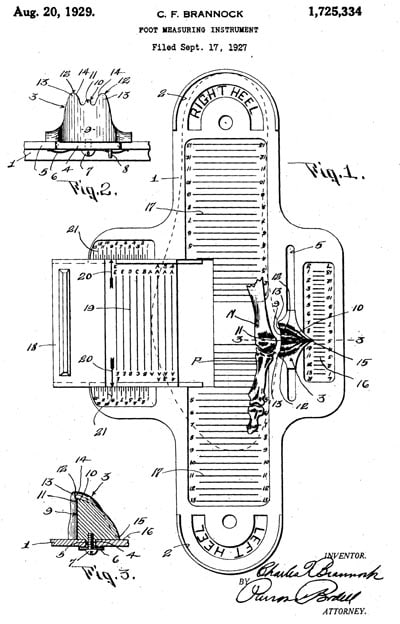
Use a Brannock device to measure your foot if you’re not sure about your size.
Another fit issue is paying attention to shoe width. Men with extremely wide or narrow feet learn about this from an early age, but many men who would be better served by just a slightly wider or narrow shoe never discover their perfect size because the normal sizes do an OK job. I challenge you to take the time to find the right size…..you’d be surprised about what you’ve been missing, especially if you spend quite a bit of time on your feet. Look for variations in arch support and toe structure as well.
4th – Take care of your shoes – We’ve written about this extensively here at the Art of Manliness. Learn how to waterproof your shoes in this classic article and then learn how to shine your shoes here.
In addition, rotate through a few pairs to allow them to dry between wearing and ALWAYS use wood shoe trees that will quickly soak up perspiration. This is especially important for leather shoes, as the interior of a dress shoe has often not gone through the harsh chemical treatment of the upper and is more susceptible to rot.
Common Footwear Terminology
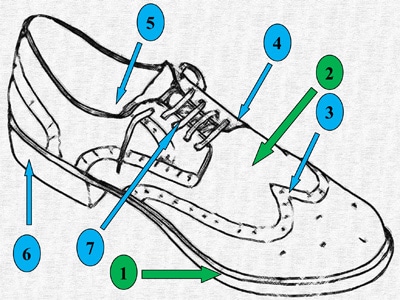
- Sole – This is commonly referred to as the bottom part of the shoe or boot and can be further divided into the outer sole, mid-sole, and insole depending on the type and quality of the shoe being discussed.
- Upper – A general term that refers to the part of the shoe above the sole.
- Brogueing – a form of ornamentation in which tiny holes are carved into the shoe’s leather. An important point to remember is that the more decoration on a shoe the less formal it becomes.
- Open Lacing – One of the two lacing systems used in oxford shoes, the open lacing system delineates the shoe in question to be a blucher. The shoe’s tongue and vamp (parts of the upper that cover the top of the foot) are cut in one piece with an open throat.
- Insole – As mentioned above, a subsection of the general term sole, the inner sole is the layer of the sole upon which the foot rests. A quality insole can mean the difference between a shoe that will last 5 years and one that will last 25.
- Heel – The back portion of the shoe that comes into direct contact with the ground and gives elevation to the foot when the shoe is worn. Heels are often built from 2 to 4 pieces of leather called lifts and reinforced with rubber or metal.
- Laces – The choice is usually round or ribbon, with round having the advantage of being stronger and more formal thanks to their core while ribbon laces come in a variety of colors and are more elastic and are thus a good choice for athletic shoes or hiking boots.

Men’s Footwear Type Overview
Types Of Dress Shoes
Oxfords are lace-up shoes built to be worn below a man’s ankle. They are commonly divided into balmorals and bluchers due to the difference in their lacing systems. Balmorals are commonly referred to simply as “oxfords,” while bluchers are referred to as derbys but rarely oxfords; all of this leads to confusion naturally. So for simplicity’s sake, I will refer to balmorals as balmoral oxfords and bluchers as bluchers.
Balmoral oxfords use a closed lacing system and are normally styled more simply than bluchers. Thus balmoral oxfords are classified as the dressier of the two; they are best worn with suits and formal wear. I advise every man to own a classic pair of balmoral oxfords to wear with his 2-piece suit.
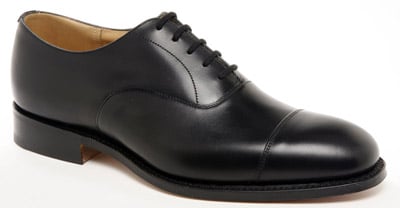
Classic English Made Oxford Balmoral
Bluchers usually come in a much wider range of styles and colors, and a conservative pair can be worn with a suit and for many men is their go-to pair of shoes to wear with the suits in their wardrobe. That being said, bluchers that utilize brogueing, a split toe, or color combinations look best with more casual clothing.
Slip-ons are not oxfords as they do not use laces; by design they are less formal although if conservatively styled they can and have been worn with suits. However, they are generally more at home with grey flannel trousers and a sport jacket. Moccasins, monk straps, and tassel loafers are just a few of the more popular options available. Many of the styles you’ll find in the slip-on category could have been classified below as casual footwear; this just highlights the fact that there are very few hard lines when dividing items like this. I personally love slip-ons, as they make travel so much easier when you have to go through 6 metal detectors over a 24 hour period.
For a more in-depth overview of men’s dress shoes click here, and for a chart overview of men’s dress shoes click here.
Types Of Casual Footwear
Saddle Shoes – A casual oxford shoe, the saddle shoe is distinctive because it utilizes a layer of leather over the instep that is normally a different color than the rest of the shoe, thus classifying it as a casual but stylish choice.
 Image from The Shoe Buff
Image from The Shoe Buff
Boat Shoes or Top Siders – Made to be worn on a boat to prevent slipping, they have migrated from the docks of Boston to the wardrobes of men looking for a summer shoe that can be worn without socks. Available in a variety of colors, the men’s boat shoe comes in a moccasin style and is only for warm weather.
 Leather Laced – Heavy Sole – The two most well known shoes in this category are Dr. Martens and Sketchers. Ranging from $40 to $200, these shoes vary in their build quality but are consistently casual in nature due to their large rubber soles and overall heavy appearance. Relying on glue and being manufactured with shoddy materials (Dr. Martens moved the production of most of their shoes and boots to China several years ago), these shoes fill a niche but are not long term value pieces and are best avoided by a man looking to build a serious wardrobe. I would say their one redeeming quality is their ability to withstand poor weather conditions, but if that’s your goal, then you should consider a quality pair of boots.
Leather Laced – Heavy Sole – The two most well known shoes in this category are Dr. Martens and Sketchers. Ranging from $40 to $200, these shoes vary in their build quality but are consistently casual in nature due to their large rubber soles and overall heavy appearance. Relying on glue and being manufactured with shoddy materials (Dr. Martens moved the production of most of their shoes and boots to China several years ago), these shoes fill a niche but are not long term value pieces and are best avoided by a man looking to build a serious wardrobe. I would say their one redeeming quality is their ability to withstand poor weather conditions, but if that’s your goal, then you should consider a quality pair of boots.
Canvas Shoes – Sneakers come in a wide variety of styles and colors, however the rules of wearing them outside of the gym are universal. When clean and situation appropriate, they work well with chinos, jeans, and shorts.
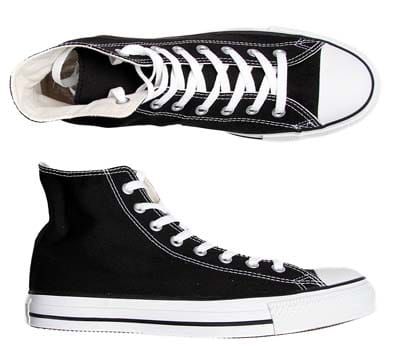
Converse – what more is there to say about this classic sneaker.
Leather Loafer – separate from the slip-on leather dress loafers above, these slip-on loafers are built with heavier rubber soles and more casual uppers to include leather imitations. Their styles are wide and range, but the purpose of their construction is to fill the void between canvas shoes and dress shoes while maximizing comfort at a value price. In the US I feel the manufacturer Clark’s does an admirable job putting out a solid shoe; outside the US, look for Ecco and their wide range of casual and comfortable footwear.
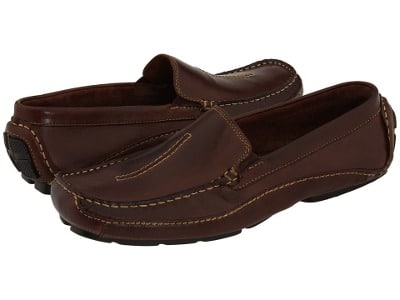 Sandals – One of man’s earliest forms of footwear, sandals continue to serve as a solid choice for protecting the bottom of our feet while allowing maximum air circulation to the upper portion.
Sandals – One of man’s earliest forms of footwear, sandals continue to serve as a solid choice for protecting the bottom of our feet while allowing maximum air circulation to the upper portion.
Clogs, Flip Flops, and Crocs – I was told that if you can’t say something nice, don’t say anything at all. So I am silent.
Athletic Shoes
Running shoes, basketball shoes, tennis shoes–you would think the occasions for which these were meant to be worn would be clear. Yet we persist in wearing our white running shoes everywhere, declaring it a right because they are comfortable. I counter this argument by saying that many of us are too lazy to take the time to think outside the box and select a casual shoe that looks sharp and is comfortable. They definitely exist.
Types Of Boots
Work Boots – There’s a cobbler I use in Green Bay whose shelves are lined with two types of footwear. High end dress shoes that need to be conditioned and shined, and work boots that have gone through a beating and need new soles. Like a pick-up truck that works hard and simply needs an oil change and new tires, quality work boots last forever and help you get the job done. Any man that works 14 hour days in construction learns at an early age that spending a bit more for quality boots is an investment in how his body will feel that weekend. And as mentioned before, solidly built work boots can be re-soled, while cheap boots that are made with glue and inferior materials not only fail under heavy usage but cannot be fixed as they were designed to be disposable.
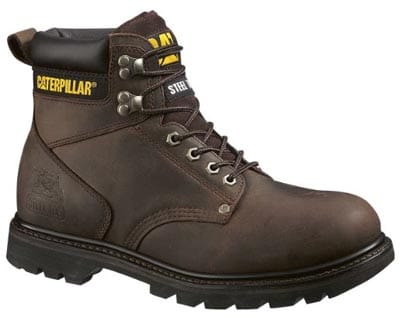
Caterpillar makes an excellent work boot – notice the stitched sole.
Hiking Boots – Hiking boots are designed to support the ankles, provide cushion, and protect from the elements, while still being light enough to not impede stamina. Boots that meet all this criteria are an outdoorsman’s delight; those that fail can turn a trip into a painful lesson of why quality matters.
Western Boots – Growing up in West Texas, I have a special place in my heart for western boots. Functionally, they serve the purpose of keeping a man in his saddle, protecting him from the terrain, and if taken care of, they can last as long as his horse. But that’s the issue–most of us don’t require this functionality and wrestle with the issue of whether or not we deserve to wear something so idealized by our culture.
Personally I feel a man can pull off western boots without being a cowboy – the key is being comfortable and confident in them. And avoid flashy or brightly colored boots unless they have a special meaning or you crafted them yourself, otherwise you’ll look like a clown.
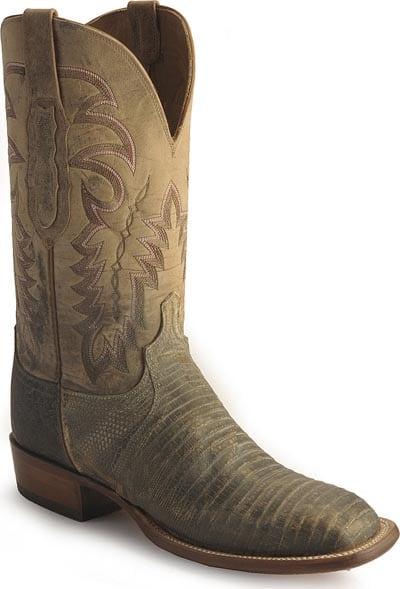
Lucchese makes an excellent boot. Just make sure to get two of them.
Dress Boots – This includes a wide variety of styles and manufacturers, from Red Wing’s Heritage collection to the classic Chelsea made famous by the Beatles. While many are built to withstand the rigors of hiking and working, they are more often than not worn for their style, not their function.

The Wolverine 1,000 mile boot. Made in the USA in a 300 step process. Brett’s an owner and a big fan.
A Note on Custom Made Shoes
If you’ve made it this far into the article, I take it you like to read about shoes. So let’s turn it up a notch and briefly discuss the option of bespoke boots and shoes. It’s not for every man, but I feel a discussion on footwear would be incomplete without it.
All shoes used to be custom; mass manufactured footwear that’s comfortable is a modern luxury. Crafted one at a time, a man’s status (much more than today) was determined by what he could afford to wear on his feet. Today the art of hand making footwear rests with a small number of artisans scattered across the globe.
First, when commissioning a pair of bespoke shoes be prepared to pay. Handcrafted shoes are expensive because modern artisans only use the finest materials, there are very few of them that do this type of work, and it’s very time intensive. And believe it or not, demand is incredibly high–waitlists of 2 to 3 years are not uncommon.
Once the process begins, a bespoke shoemaker will first carefully examine your foot. He’ll consult with you on the best style and design for your body and professional needs, then build lasts (replicas of your feet) which the shoe will be built around.
After this, the artisan performs his magic. He’ll carefully select the right materials and then cut the insole, prepare the upper, prepare and then stitch the welt, sole the shoe, attach the cork filling and insert a steel shank spring, stitch on the outsole, build the heel, and then finish everything with final shaping and ornamentation.
This intensive process takes most shoemakers approximately 10 weeks for a single pair. If you’re looking for a great read on the subject, pick-up the book Handmade Shoes for Men. If you’re looking at custom shoes, consider speaking with Steven over at Leffot. But be careful about reading his men’s shoe blog: you might get sucked in for hours.

Footwear like this has to be made for you……..
A Man’s Guide to Footwear – In Conclusion
As previously stated, my goal here was to give you an overview of your options. Each type of footwear we discussed has its own history and could easily have been its own article. In fact, I’ll leave you with that. What piece of footwear would you like to see us write more about?
See you in the comments!
Written by
Antonio Centeno
President, A Tailored Suit
Founder, Real Men Real Style


